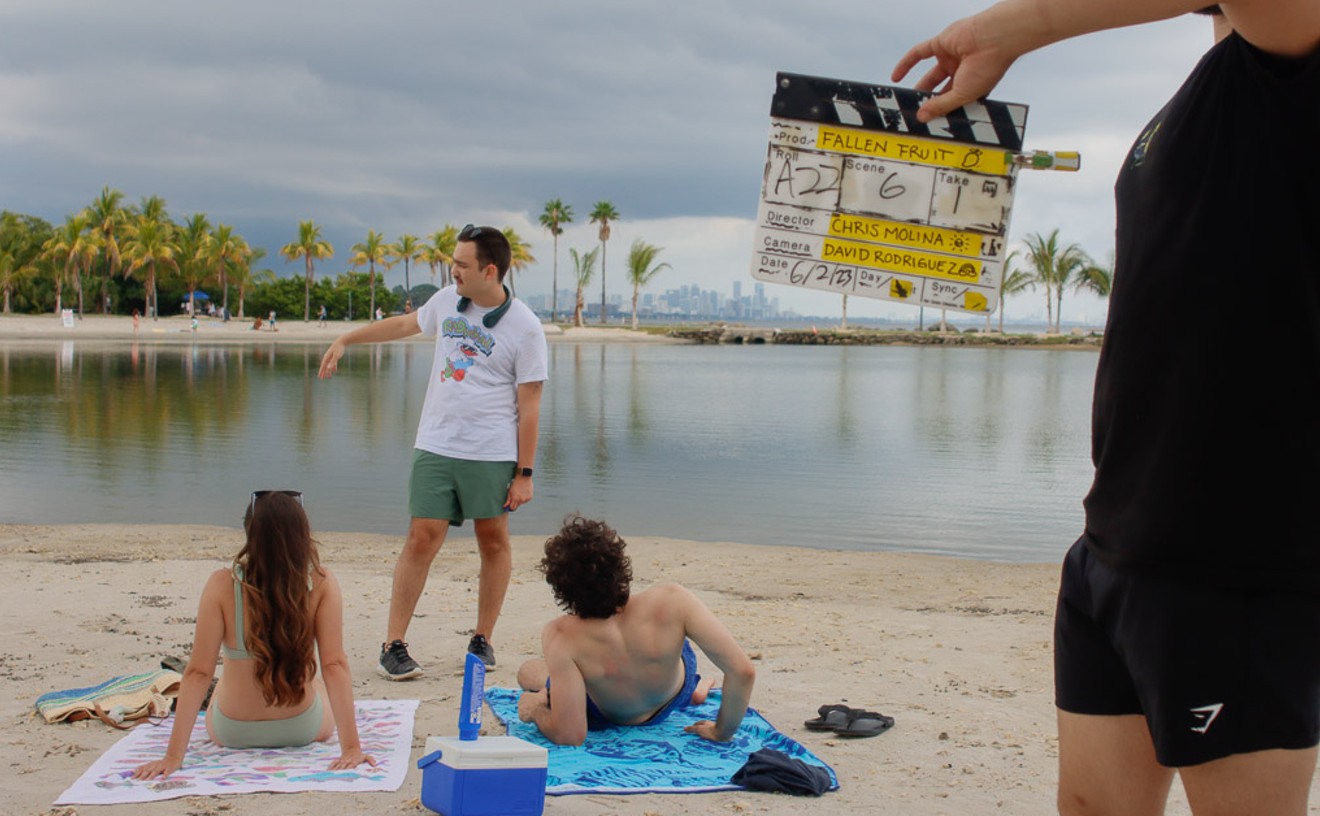Artists in the 305 are a creative bunch. They find new and unique ways of creating and also performing art, not to mention displaying it. Multimedia artist Dinorah de Jesús Rodriguez has done just that -- projecting her avant garde film project onto the exteriors of houses during Art Basel.
Says Rodriguez, "Miami Remix, a trance film composed of whirling kaleidoscopic mandalas created from hand-drawn and hand-scratched film images of local Miami landscapes, originally made its public debut in 2011 at the main branch of the Miami Beach Public Library, and has been streaming on YouTube for online audiences for over a year. But this year, during Art Basel, the piece [finally came] out of its digital closet and [took] to the streets of the city that inspired it."
See also:
- The Art Cops on Art Basel 2012's Worst Offenders and Attempting to Bust Banksy for Crimes Against Art
- Robert Rodriguez Punches New Times Reporter, Talks About His El Rey Network
- Art Basel Miami Beach 2012: Winners and Losers
This past Friday and Saturday, Miami Remix was projected onto the exteriors of two homes in Buena Vista, namely the home of Todd Kessler and Rosa Lowinger at 29 NE 42nd Street, exactly one block North of the De la Cruz Collection as well as at the home of landscape designer Ian Simpkins at 46 NE 43rd Street.
The artist explains that each projection resulted in a different experience, as the piece adapted itself to its projection space. Her intent was for these street-level installations to expose people to her work even if they just happened to be driving by. Additionally, residents and art scouts would be able to experience her work even if they were just in the area looking for parking.
She explains, "Having the work in the street instead of a gallery means a lot to me. I want to engage neighborhood people, folks driving by, Miami people, homeless people, tourists, folks just getting home from work. I want to engage neighbors who are out walking their dogs. I want to engage the dogs, too."
Cultist likes that concept. She continues, "For every viewer, the piece will represent a different set of images, frequencies and vibrations, as each will probably only experience a very personal and specific few seconds of the total work. That's fine and as it should be. As an artist, I would be bored to tears to have a bunch of people just standing in front of the work looking at it from beginning to end. I want it to get inside people's subliminal aural field and move through them. The whole act can and should be mostly subconscious."
Read on for our Q&A with the unique artist.
Cultist: What inspired you to make this work?
Dinorah de Jesús Rodriguez: Miami Remix came about after a project that I did in 2010 called Elusive Landscape, which featured 16mm film footage that I shot of five local landscapes, and which I then drew and painted over and projected back onto the landscapes themselves. The landscapes included Vizcaya Gardens, Sewell Park, Legion Park in Little Haiti, and others. Afterwards, I took this footage and digitized it, adding a kaleidoscope effect. This became Miami Remix and for me, it represents a way of looking at these local landscapes through a cosmic lens, reducing the images to their energetic molecular level. Essentially, the piece is really about the energy of Miami.
Who are your greatest influences as a film and video artist?
Very early in my career, I was greatly inspired by the work of Len Lye, Stan Brakhage and Norman McLaren, who were well-known for painting and scratching directly onto the celluloid, a process that Lye defined as "direct filmmaking." This practice remains essential to about 90% of my work. Most of my work originates in 16mm film -- a very physical, chemical medium. Translating the work from film to video is where I add other effects and aesthetics. Much of my psychedelic aesthetic is a product of the fact that I was a teenager in the U.S. during the '70s, and probably all of us were influenced to some degree by that culture. My expansion from experimental filmmaking into installation work is greatly inspired by the works of such artists as Nam Joon Paik, Isaac Julien and Pipilotti Rist. The desire to further make the work site-specific responds to recent trends by many artists that express a need to make art that is ephemeral in nature and creates a dynamic dialogue with the location and audience where it is presented.
What motivated you to exhibit this work at street-level and not in a regular gallery?
I love putting my work in locations where people will be surprised by it. For me, taking the work to the street level is the most important aspect of this piece, as it speaks to both the audience and inspiration of the work: Miami itself, not only as a city but as an entire ecosystem. The work will, however, be exhibited at Inkub8 which -- though not a gallery -- is a very popular performing arts space in Wynwood. This will give those really interested in viewing the detail in the work an opportunity to see it exhibited at a higher resolution and in a more "art space" type setting.
What do you hope that people will walk away with after seeing Miami Remix?
Miami Remix is a trance-film that invokes a meditational state in the viewer. It is my hope that people will walk away energized, refreshed and uplifted by the kinetic energy of the work. I also hope that the work opens an internal dialogue in the viewer that will make them question how they see the world around them and consider the subtle, molecular energy of everything that surrounds them.
What will you do next?
I'm thinking of continuing these street projections of Miami Remix for a few more months and hopefully install it all over Miami, particularly in the neighborhoods where the footage was originally shot. It's all about creating a dialogue between myself as an artist and residents of the community who are interested in hosting an evening of public art on the façade of their home as a gift to their immediate neighborhood.
Follow Cultist on Facebook and Twitter @CultistMiami.










